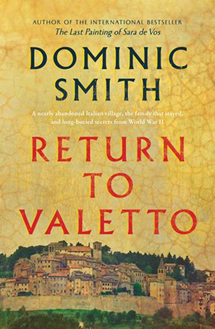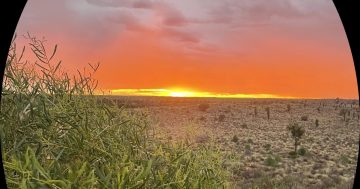Reviewed by Robert Goodman.
By Dominic Smith, Allen and Unwin, $32.99.
 Dominic Smith takes readers to Northern Italy in his sixth novel Return to Valetto and brings with him the richness and descriptive power that characterised his earlier novels. While his last couple of novels revolves around art and artists (The Last Painting of Sara de Vos and The Electric Hotel) they had an interest in history and the impacts of historical events which are strong themes in Return to Valetto. And to ensure that those points can be easily made within the narrative the main character is a history academic.
Dominic Smith takes readers to Northern Italy in his sixth novel Return to Valetto and brings with him the richness and descriptive power that characterised his earlier novels. While his last couple of novels revolves around art and artists (The Last Painting of Sara de Vos and The Electric Hotel) they had an interest in history and the impacts of historical events which are strong themes in Return to Valetto. And to ensure that those points can be easily made within the narrative the main character is a history academic.
Hugh Fisher is a historian with an interest in disappearing towns and villages. And nothing exemplifies his interest more than the town of Valetto in Northern Italy, perched on a hillside ravaged by numerous earthquakes which now has a population of ten. Valetto is the town where Hugh’s mother Hazel grew up before moving to America and settling down there. Hugh spent much of his childhood in Valetto staying with his mother’s three sisters and his ageing Grandmother Ida. When Hugh returns as a successful academic and to attend his grandmother’s hundredth birthday celebrations he walks into a controversy – the little house behind the family villa, left to him by his mother, is being occupied by a woman called Elisa Tomassi. Elisa has a letter written by Hugh’s grandfather Aldo during the Second World War leaving the cottage to Elisa’s family. Aldo had been cared for by Elisa’s grandparents after he joined the partisans but more than that, prior to this Elisa’s mother Alessia had been sheltered at the villa along with a number of other children during the later war years. In unravelling the family connections and a mystery involving his own mother and Alessia as young girls, Hugh will unleash the past and put his family on a course to seek a reckoning.
There is plenty of melodrama in Return to Valetto and a plot that revolves around wrongs that are discovered and need to be righted. But what centres the novel is Smith’s gentle depiction of Hugh, a man still struggling with the death of his wife, seeking solace and comfort in the beauty and nostalgia of Valetto but also trying to steer his family through some difficult revelations. All of which anchored by Smith’s gorgeous prose:
As we rounded the bend and descended from the plateau, [Milo] gestured towards Valetto, at his unlikely birthplace barnacled to a spur od rock in the middle of a valley of canyons. From a distance, the town is a faint, medieval silhouette atop a pinnacle, set against the haze of distant hill towns, their fields and slopes and church spires arranged around the edges of a blue bowl. But then as you get closer, the colours come into relief – the pale umber walls, the surrounding moonscape of chalk-white canyons and escarpments, the fringe of chestnut and olive groves at the base of its cliffs. Still closer, it becomes a diorama of windows and terracotta roof tiles… The skyline is beautiful but also desolate and otherworldly.
And in amongst all of this beauty is a reckoning with the past. Smith’s story takes in the fascist collaborators and the partisans of World War II and the continuing impact of this conflict on the people of the region. Smith does this while considering the nature of history, how it is constructed and reconstructed over time. As Hugh muses:
We want history to be a unified narrative, a casual, linear plot that cantilevers across the centuries, but I’ve always pictured it like a filigree of a wrought-iron gate, our unaccountable lives twisting and swooping against a few vertical lines.
Return to Valetto is another beautiful and effective novel from Smith. It is a compassionate and affecting tale full of memorable characters set within a stunning yet melancholy landscape. Its bait and switch from a seemingly petty property dispute to something much deeper and darker also sets up a finale that is both incredibly tense and also cathartic, not only for the characters but to some extent for the reader.
Over 900 more book reviews can be found on Pile by the Bed.











